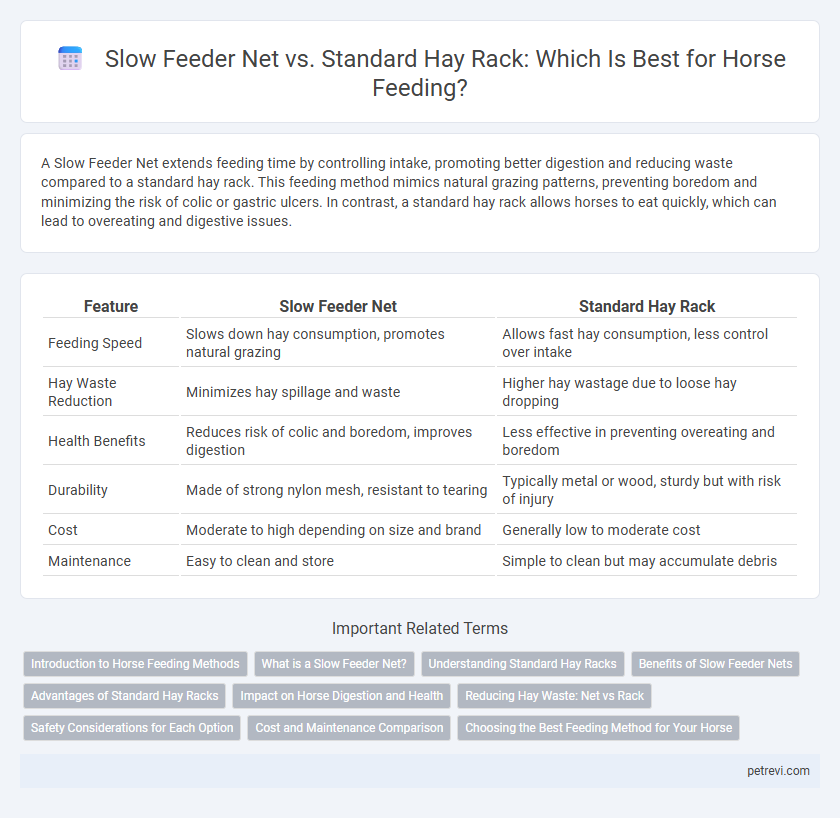A Slow Feeder Net extends feeding time by controlling intake, promoting better digestion and reducing waste compared to a standard hay rack. This feeding method mimics natural grazing patterns, preventing boredom and minimizing the risk of colic or gastric ulcers. In contrast, a standard hay rack allows horses to eat quickly, which can lead to overeating and digestive issues.
Table of Comparison
| Feature | Slow Feeder Net | Standard Hay Rack |
|---|---|---|
| Feeding Speed | Slows down hay consumption, promotes natural grazing | Allows fast hay consumption, less control over intake |
| Hay Waste Reduction | Minimizes hay spillage and waste | Higher hay wastage due to loose hay dropping |
| Health Benefits | Reduces risk of colic and boredom, improves digestion | Less effective in preventing overeating and boredom |
| Durability | Made of strong nylon mesh, resistant to tearing | Typically metal or wood, sturdy but with risk of injury |
| Cost | Moderate to high depending on size and brand | Generally low to moderate cost |
| Maintenance | Easy to clean and store | Simple to clean but may accumulate debris |
Introduction to Horse Feeding Methods
Slow feeder nets regulate hay consumption by forcing horses to eat smaller portions over extended periods, promoting better digestion and reducing waste. Standard hay racks allow horses to access larger quantities quickly, which can increase the risk of overeating and digestive issues like colic. Integrating slow feeders supports natural grazing behavior and helps manage weight, making them a preferred choice for many equine nutritionists.
What is a Slow Feeder Net?
A slow feeder net is a specially designed hay net with smaller mesh openings that control the horse's hay intake by slowing down the eating process and promoting natural foraging behavior. This feeding tool reduces waste, prevents overeating, and lowers the risk of digestive issues such as colic and laminitis. Compared to standard hay racks, slow feeder nets encourage prolonged chewing and improve mental stimulation, benefiting the horse's overall well-being.
Understanding Standard Hay Racks
Standard hay racks for horse feeding provide easy access to large quantities of hay but often allow rapid consumption, leading to increased risk of choking and digestive issues. These racks typically feature open slats or bars, which do not restrict the horse's intake speed, causing horses to eat hay too quickly compared to slow feeder nets. Understanding that standard hay racks do not promote natural foraging behavior highlights their limitations in controlling eating pace and improving digestive health in horses.
Benefits of Slow Feeder Nets
Slow feeder nets regulate a horse's hay intake by mimicking natural grazing patterns, reducing the risk of obesity and colic while promoting better digestion. They help minimize hay wastage by preventing horses from pulling large mouthfuls and trampling on hay, ultimately saving feed costs. Slow feeder nets also encourage mental stimulation and reduce boredom by extending feeding time compared to standard hay racks.
Advantages of Standard Hay Racks
Standard hay racks offer superior durability and ease of use compared to slow feeder nets, making them ideal for various equestrian environments. They promote cleaner feeding areas by keeping hay off the ground, reducing waste and the risk of ingestion of dirt or manure. Standard hay racks also support natural eating postures, which can enhance digestion and reduce strain on the horse's neck and back.
Impact on Horse Digestion and Health
Slow feeder nets promote better horse digestion by encouraging slower intake of hay, which mimics natural grazing behavior and reduces the risk of colic and gastric ulcers. Standard hay racks allow quicker consumption, often leading to increased ingestion rates and potential digestive upset. Using slow feeder nets supports a healthier digestive system and sustained nutrient absorption in horses.
Reducing Hay Waste: Net vs Rack
Slow feeder nets reduce hay waste by controlling a horse's eating speed, preventing rapid consumption and minimizing spillage. Standard hay racks allow horses to pull out large amounts of hay quickly, often leading to increased waste beneath the rack. Using slow feeder nets can lower hay wastage by up to 50%, promoting more efficient feed utilization and cost savings.
Safety Considerations for Each Option
Slow feeder nets reduce ingestion speed, minimizing the risk of choke and colic, while demanding careful monitoring to prevent entanglement or limb injuries. Standard hay racks provide easy access but may encourage rapid eating, increasing the chances of choke and respiratory issues due to dust inhalation. Both options require secure installation and regular inspection to ensure the horse's safety during feeding.
Cost and Maintenance Comparison
Slow feeder nets typically incur a higher initial cost compared to standard hay racks, but they can reduce overall hay consumption and waste, leading to long-term savings. Maintenance for slow feeder nets involves regular inspection for wear and cleaning to prevent mold, whereas standard hay racks require less frequent upkeep but may contribute to faster hay spoilage and increased feed costs. Choosing between the two depends on balancing upfront investment with ongoing operational efficiency and feed preservation.
Choosing the Best Feeding Method for Your Horse
Choosing between a slow feeder net and a standard hay rack depends on your horse's eating habits and nutritional needs. Slow feeder nets promote slower consumption, reducing risk of digestive issues and encouraging natural grazing behavior, while standard hay racks offer easier access but may lead to faster eating and increased waste. Prioritize your horse's health by selecting a feeding method that minimizes ingestion of dust and mold while supporting consistent, controlled intake.
Slow Feeder Net vs Standard Hay Rack for Horse Feeding Infographic

 petrevi.com
petrevi.com